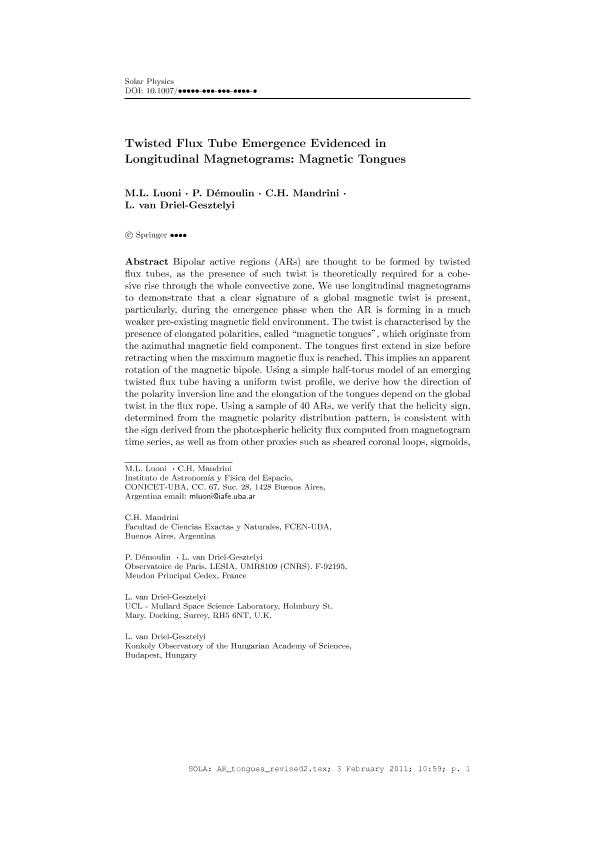Mostrar el registro sencillo del ítem
dc.contributor.author
Luoni, Maria Luisa

dc.contributor.author
Démoulin, Pascal

dc.contributor.author
Mandrini, Cristina Hemilse

dc.contributor.author
van Driel Gesztelyi, Lidia

dc.date.available
2017-07-06T21:31:21Z
dc.date.issued
2011-05
dc.identifier.citation
Luoni, Maria Luisa; Démoulin, Pascal; Mandrini, Cristina Hemilse; van Driel Gesztelyi, Lidia; Twisted Flux Tube Emergence Evidenced in Longitudinal Magnetograms: Magnetic Tongues; Springer; Solar Physics; 270; 1; 5-2011; 45-74
dc.identifier.issn
0038-0938
dc.identifier.uri
http://hdl.handle.net/11336/19827
dc.description.abstract
Bipolar active regions (ARs) are thought to be formed by twisted flux tubes, as the presence of such twist is theoretically required for a cohesive rise through the whole convective zone. We use longitudinal magnetograms to demonstrate that a clear signature of a global magnetic twist is present, particularly, during the emergence phase when the AR is forming in a much weaker pre-existing magnetic field environment. The twist is characterised by the presence of elongated polarities, called “magnetic tongues”, which originate from the azimuthal magnetic field component. The tongues first extend in size before retracting when the maximum magnetic flux is reached. This implies an apparent rotation of the magnetic bipole. Using a simple half-torus model of an emerging twisted flux tube having a uniform twist profile, we derive how the direction of the polarity inversion line and the elongation of the tongues depend on the global twist in the flux rope. Using a sample of 40 ARs, we verify that the helicity sign, determined from the magnetic polarity distribution pattern, is consistent with the sign derived from the photospheric helicity flux computed from magnetogram time series, as well as from other proxies such as sheared coronal loops, sigmoids,
dc.format
application/pdf
dc.language.iso
eng
dc.publisher
Springer

dc.rights
info:eu-repo/semantics/openAccess
dc.rights.uri
https://creativecommons.org/licenses/by-nc-sa/2.5/ar/
dc.subject
Active Regions
dc.subject
Magnetic Fields
dc.subject
Corona: Structures
dc.subject
Magnetic Helicity
dc.subject.classification
Astronomía

dc.subject.classification
Ciencias Físicas

dc.subject.classification
CIENCIAS NATURALES Y EXACTAS

dc.title
Twisted Flux Tube Emergence Evidenced in Longitudinal Magnetograms: Magnetic Tongues
dc.type
info:eu-repo/semantics/article
dc.type
info:ar-repo/semantics/artículo
dc.type
info:eu-repo/semantics/publishedVersion
dc.date.updated
2017-07-06T13:03:55Z
dc.journal.volume
270
dc.journal.number
1
dc.journal.pagination
45-74
dc.journal.pais
Alemania

dc.journal.ciudad
Berlín
dc.description.fil
Fil: Luoni, Maria Luisa. Consejo Nacional de Investigaciónes Científicas y Técnicas. Oficina de Coordinación Administrativa Ciudad Universitaria. Instituto de Astronomía y Física del Espacio. - Universidad de Buenos Aires. Facultad de Ciencias Exactas y Naturales. Instituto de Astronomía y Física del Espacio; Argentina
dc.description.fil
Fil: Démoulin, Pascal. Centre National de la Recherche Scientifique. Observatoire de Paris; Francia
dc.description.fil
Fil: Mandrini, Cristina Hemilse. Consejo Nacional de Investigaciónes Científicas y Técnicas. Oficina de Coordinación Administrativa Ciudad Universitaria. Instituto de Astronomía y Física del Espacio. - Universidad de Buenos Aires. Facultad de Ciencias Exactas y Naturales. Instituto de Astronomía y Física del Espacio; Argentina
dc.description.fil
Fil: van Driel Gesztelyi, Lidia. Centre National de la Recherche Scientifique. Observatoire de Paris; Francia
dc.journal.title
Solar Physics

dc.relation.alternativeid
info:eu-repo/semantics/altIdentifier/url/https://link.springer.com/article/10.1007/s11207-011-9731-8
dc.relation.alternativeid
info:eu-repo/semantics/altIdentifier/doi/http://dx.doi.org/10.1007/s11207-011-9731-8
Archivos asociados
